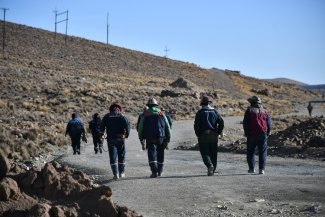The financial crisis at the national electric company Empresa Nacional de Energía Eléctrica (ENEE) has, after several years, reached the stage that intervention by outside investors is unavoidable.
The rescue and recovery plan proposed by the national energy workers’ union Unión de Trabajadores de la Industria Energética Nacional (UTEN) reached the office of Honduran President Porfirio Lobo on 11 September, 2013.
It is backed by Colombian financing amounting to US$306 million with conditions stipulating one year’s grace and seven years for repayment at an annual interest rate capped at eight per cent.
Under the slogan, "Alternative trade unionism towards a new business model", Colombian workers have joined forces with the Honduran workers from the national electricity company union STENEE and the national union confederation CGT, in a bid to, firstly, rescue the company with a cash injection and then manage the technical and organisational aspects of electricity generation, transmission and supply.
A shift in Honduran trade unionism
In an interview with Equal Times, Professor Mario Posas, a close observer of the Honduran trade union movement, said there is a “broad consensus” that the ENEE and the national telecommunications company, HONDUTEL, “have been the victims of unrelenting corruption, plundered to the point that they have been left with no capital, so that they can be privatised and sold off for a pittance.”
“For many years,” said Posas, “the banana workers’ unions were at the forefront of the trade union movement, but a radical change was set in motion after Hurricane Mitch in 1998.”
According to Posas, this event “marked the beginning of a decline in the banana sector’s importance in terms of foreign trade” and “the place left vacant by the banana workers’ unions was occupied by unions representing workers in state-run services.”
Among these trade unions was the STENEE, which was “one of the most combative in the country,” according to Posas.
The government of President Rafael Callejas Romero, in power from 1990 to 1994, “decapitated the union’s executive, chaired by Gladys Lanza, and turned it into a docile organisation.” Over recent years, however, the STENEE, as Posas explains, “has regained its place as a combative union.”
Professor Posas underlines that the rescue of the ENEE “is without precedent in the annals of the Honduran trade union movement” and this intervention should be interpreted as “part of the STENEE leadership’s efforts to save jobs and ensure that this state-owned company remains in the hands of the Honduran people, those who work for it and those who receive the company’s services.”
A paradigm without precedent
Honduran trade unions, despite being the last to obtain legal recognition in Latin America (in 1954), have in the past succeeded in obtaining reforms and securing representation in a number of state institutions, alongside employers’ organisations.
In addition to this political role, trade unions have now developed a financial capability, derived from their members’ pension funds, which can now be put to good use, to rescue the companies on which the workers depend.
The ENEE looks set to see the inauguration of a Honduras-Colombia transnational trade union participation model, which may also be backed, according to reports in LaPrensa.hn and ElHeraldo.hn, by electricity sector unions from Costa Rica and El Salvador.
This move to save a failing company, a company of strategic importance to the whole nation, as it provides state-run electricity services and is crucial in terms of employment, heralds a transformation in the role of trade unions and the nature of industrial relations.
An unprecedented model is currently taking shape in Honduras, a model capable of going beyond mitbestimmung – Germany’s co-management system – whereby, depending on the size of the company, workers are given a say in business decisions, without having invested capital.
So, if workers sit on the board as investors, what will happen when there is a clash between business interests and the workers’ rights?
The core issue
According to the statistics of the Economic Commission for Latin America and the Caribbean (ECLAC) on the electricity sector in Central America, Honduras has the region’s highest percentage in terms of losses of the electrical energy produced. This figure rose from 20.6 per cent in 2008 to 27 per cent in 2011.
The other Central American countries saw losses lower than those of Honduras in 2011: 24.1 per cent in Nicaragua, whilst in Panama, Guatemala, Costa Rica and El Salvador they stood at between 12 and 13 per cent.
Miguel Aguilar, president of the STENEE, already commented in July on the figures for 2012, stating that the energy losses of around 29.8 per cent amounted to the equivalent of US$408 million, thus highlighting the ENEE’s weak point.
Emil Hawit, the director of the ENEE, stated that the liabilities accumulated by the company during the first half of 2013 alone amounted to US$220 million.
The government of President Lobo is, for its part, convinced that the state-owned company can only survive if it finds an international partner to inject capital and pave the way for investments to modernise electrical power generation and transmission as well as public electricity supply.
The negotiations between the Honduran government, the banks, the company and the Latin American unions interested in rescuing the ENEE are moving forward, trying to strike a delicate balance between the different interests at stake.









